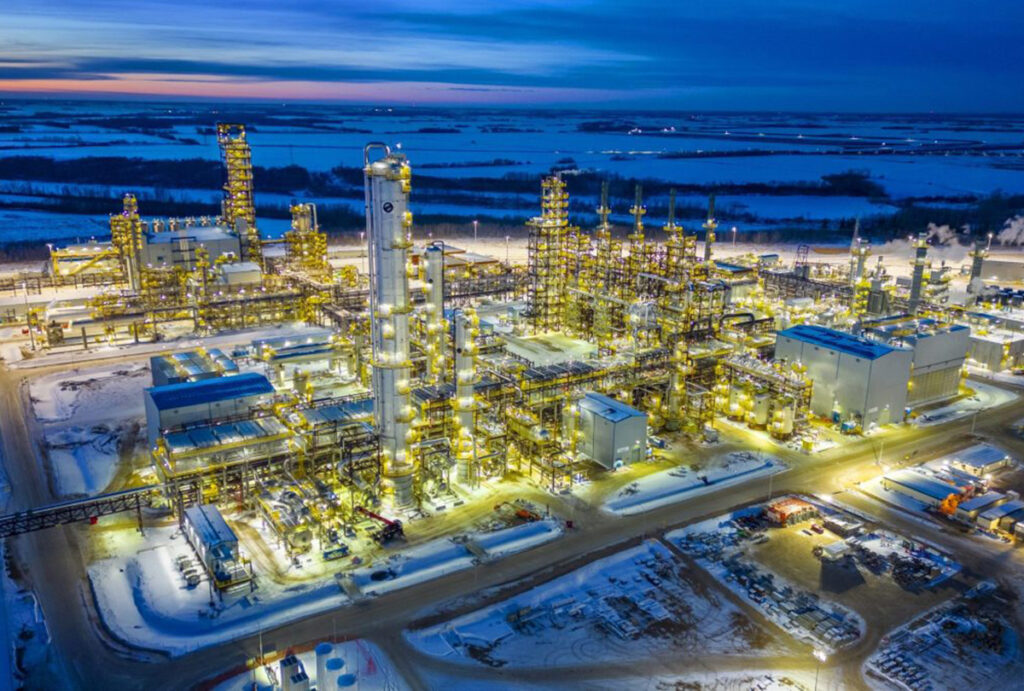‘This region really is an economic engine for the region, for the province and for the country’
Follow CEC on LinkedIn CEC LinkedIn
Follow CEC on Facebook CEC Facebook
Follow CEC on Twitter CEC Twitter

The Heartland Petrochemical Complex near Edmonton, Alberta. Photo courtesy Inter Pipeline Ltd.
Alberta’s Industrial Heartland Association (AIHA) is celebrating its silver anniversary this year.
Over its 25 years, the association has built impressive legacy of attracting more than $45 billion in capital investment and more than 40 companies to the region, providing fuels, fertilizers, power, petrochemicals and more to provincial and global consumers.
The 582-sq.-km. area, just northeast of Edmonton, has become one of the world’s most attractive places for chemical, petrochemical, oil, and gas investment.
And the future for investment continues to be bright.
“I like to call the Alberta Industrial Heartland region the heartbeat of Alberta,” said Dave Diduck, Chair of the AIHA and Reeve of Lamont County, describing the region as a world-class regional cluster of industries.
“It generates significant revenue for the province, creates good-paying, stable jobs for thousands of Albertans, supports local communities, and truly demonstrates the opportunity of the Alberta Advantage. Without the Heartland, the province of Alberta would not be where it is right now.”
Alberta’s Industrial Heartland is a pre-zoned, heavy industrial area, and Canada’s largest hydrocarbon processing region.
Founded in 1999, the AIHA is a non-profit organization created to attract investment to the region. It has five municipal partners with land within the Heartland – City of Fort Saskatchewan, Lamont County, Strathcona County, Sturgeon County and City of Edmonton, as well as associate members including the towns of Bruderheim, Gibbons and Redwater.
Mark Plamondon, executive director of the AIHA for the last seven years, said the region offers opportunity for businesses that prioritize responsible investment.
“The opportunity for companies to meet both their environmental and their economic goals here in the Heartland really positions this region very well from a growth perspective going forward because companies are more and more focused on that,” he said.
“Of course, you need to have a strong economic business case but you also need to be able to either decarbonize your production or produce a product in a more environmentally-sustainable manner than maybe historically.
A key objective for the AIHA is improving the business case for the Industrial Heartland. That means identifying infrastructure pinch points and working with governments to alleviate them. It also includes identifying the competitive landscape from a tax and incentive standpoint compared to other jurisdictions, working with governments to understand where there is a lack of competitiveness.
Plamondon said over the last 10 years about $15 billion in investment has been added.
“Going forward, we’re fortunate that Dow (Chemical) announced the final investment decision of their large-scale, world’s first net zero ethylene manufacturing production here in the Industrial Heartland. They announced a cap number in US dollars, but that excluded some auxiliary sites like hydrogen production, etc., so we think that investment will exceed $10 billion Canadian,” he said.
“There’s a number of companies looking at hydrogen and ammonia production facilities for exports to Asian markets. If one of those goes or two of those go, that brings another amount of capital into this region of an additional $15 or so more billion.”

Dow CEO Jim Fitterling speaks at the announcement the company will construct the world’s first net-zero carbon emissions ethylene and derivatives complex, in Fort Saskatchewan Alberta, on Wednesday November 29, 2023. Canadian Press photo
Plamondon said the surge in investment interest has been driven by the region’s low-cost feed stock competitive advantage in the Industrial Heartland coupled with carbon capture sequestration capability.
“This region really is an economic engine for the region, for the province and for the country,” he said.
In addition to its technical advantages, Lamont County Reeve Diduck noted the Industrial Heartland also offers incentive programs, carbon capture technology, streamlined regulatory approvals, a favourable tax structure and stable and democratic governance.
“The association has evolved into a dedicated and professional team with the knowledge and expertise to converse, negotiate, and attract industry to Alberta’s Industrial Heartland,” he said.
“The availability of carbon capture technology and infrastructure within the Heartland, such as Alberta Carbon Truck Line, is a key tool that AIHA uses to promote future growth and expansion in the region.
“As the Alberta Industrial Heartland continues to expand, the cluster of world-class industries in the region will expand and the industries will be able to draw on each other for support, exchange feed stocks, and create synergies.”
The unaltered reproduction of this content is free of charge with attribution to Canadian Energy Centre Ltd.
Share This:



